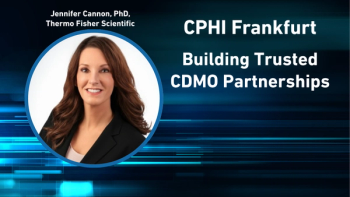
Pharmaceutical Technology Europe
- Pharmaceutical Technology Europe-11-01-2004
- Volume 16
- Issue 11
Early development services lead the way for CRO Industry
A big problem for the industry seems to be that Phase II has become something of a 'black hole' for drug development; new drug candidates can't seem to escape once they enter.
It has been a banner year for companies providing early development services, including preclinical and Phase I research, bioanalytical and analytical chemistry, and clinical trial materials manufacturing and packaging. In the first half of 2004, most clinical research organizations (CROs) saw revenue gains of 20% or more in their early development services, with preclinical, Phase I and analytical chemistry particularly strong. The only weak spot was Phase I studies in Europe, where the new Clinical Trials Directive (CTD) seems to have retarded activity somewhat. European Phase I activity was particularly strong last year, and it may be that pharmaceutical companies accelerated a number of programmes in advance of the tougher CTD requirements.
Demand for early development services is being driven by big pharma's efforts to improve the efficiency of its R&D operations by moving more candidates through the pipeline more quickly; and by the improved funding environment for early stage companies. Some CROs are also reporting that Phase I studies are getting longer and more complex.
Downstream services have yet to feel the favourable impact of the strong early development activity. CROs reported weak gains or actual declines in late development revenues. Phase III studies, with their large patient populations, global scope, and great use of central laboratory services, are the real money-makers in late development, but actual billable activity in that area is down. Demand for line extension studies (so-called Phase III-B studies) and post-approval studies (Phase IV) has been stronger, but they are usually lower cost than studies for new molecular entities.
Black hole
A big problem for the industry seems to be that Phase II has become something of a 'black hole' for drug development; new drug candidates can't seem to escape once they enter. In a recent analysis of their own data, the editors of the
Pharmaprojects
database found that the number of candidates in Phase II grew 7% from May 2003 to May 2004, and is now 50% higher than the number of drugs in Phase I. The number of candidates in Phase III was essentially flat from May 2003 to May 2004.
A principal explanation for what is occurring is that pharmaceutical companies are getting more aggressive in killing candidates before they move into the expensive late development stages. Increasingly, companies have divided the Phase II research stage into Phase II/A, which involves small proof-of-concept studies, and Phase II/B, which are larger efficacy studies. The ideal time to kill a candidate is immediately after Phase II/A, and many companies are doing just that. Industry planners now assume that Phase II survival rates for new drug candidates have fallen below 50%.
aaiPharma turns to CRO veteran
aaiPharma (whose parent is AAI Development Services), a CRO with US and European operations, named Ludo Reynders as president and CEO in September. The move appears to be part of a strategy by the company's board of directors and creditors to put it back onto a solid financial footing following a disastrous effort to reposition aaiPharma as a specialty pharma company. aaiPharma made a series of acquisitions in recent years of late life cycle products from major pharmaceutical companies. The company never forsook its development services business, but proprietary products accounted for more than 60% of revenues in 2003 and company executives seldom mentioned the CRO business in presentations to investors and Wall Street analysts.
However, earlier this year, the company's board of directors uncovered instances of "channel stuffing" in the proprietary products business; that is, selling products to wholesalers in quantities well in excess of what was being bought at retail. The practice enabled the company to inflate reported revenues and earnings.
The investigation led to a restatement of aaiPharma's 2003 financial performance from what was announced in February 2004. Revenues were cut to $225 million from the $283 million reported in February, and the company reported an operating loss of $21 million rather than the $69 million profit previously reported. The fallout from the investigation went beyond the restatement, however. The company defaulted on its substantial debt to banks and other lenders, and only fast action by an interim president with experience in corporate restructuring saved the company from a bankruptcy filing. Several senior executives, including the then-CEO and chief financial officer, were forced to resign.
Frederick Sancilio, aaiPharma's founder, also appears to have been forced out. In addition to ceding the CEO spot to Reynders, Sancilio also relinquished his roles of chairman of the board and chief scientific officer. He will remain on the board of directors until his term ends in 2006. It appears that aaiPharma's creditors are effectively in control of the company after the company missed a $10 million interest payment, which was due on 1 October, to holders of its senior subordinated notes. The company also warned that it was likely to be in default of some covenants under its senior credit facility, and would be seeking waivers from its senior creditors. In early October, the company announced that it had hired an investment bank to explore the possibility of selling some of its assets; it was not clear whether this meant proprietary products or service-related assets.
Reynders is a veteran contract services executive and could take the company back in that direction. Until 2003, Reynders was a senior executive at Quintiles Transnational Corp., where he served as CEO of its development services businesses and managing director of its PharmaBio Development venture capital group. He was highly-respected by industry analysts and colleagues while at Quintiles.
With the changes in aaiPharma's proprietary products business, its AAI Development Services business now accounts for nearly 50% of corporate revenue. Contract services revenues were up nearly 20% in the first half of 2004. The company offers both clinical and non-clinical research services, including analytical and bioanalytical chemistry, formulation development, and manufacturing of clinical trial materials. It has operations in Paris, New Ulm (Germany) and Arnheim (The Netherlands).
Equipment sales expanding
Business development executives for parenteral manufacturing equipment makers report that their business is growing again after some slow years. Demand for parenteral manufacturing capacity has been expected to boom because of the many biopharmaceuticals and small molecule cancer drugs in the pipeline. Bob Briggs, director of sales and marketing at Cozzoli Machine Company (
www.cozzoli.com
), a manufacturer of filling equipment, says that "inquiries are up exponentially" this year. Tom Kelly, account manager at Hull (
www.hullcompany.com
), which makes freeze-dryers, says orders have been on the upswing in the last 1-2 years after a slowdown in the late 1990s and early part of this decade. Because the delivery cycle from order to delivery is 18 months, and installation and validation can take another 6-12 months, equipment ordered will impact available capacity in 2-3 years' time.
The big driver of demand seems to be replacement of aging equipment, more so than demand for new capacity. "There is a pent up need," says Briggs. "Companies have been nursing some equipment along." Because it has the most legacy capacity, big pharma has been the major driver for replacement spending.
To the extent that big pharma has been investing in new facilities, those facilities have been in locations offering either favourable tax treatment or lower costs, according to the people we talked to. Ireland and Puerto Rico are two countries benefiting from this offshore trend. Some small companies have been investing in new facilities for clinical or commercial production, but it appears that most small pharma and biopharma companies are going the route of contract manufacturing. In fact, the equipment manufacturers report that contract manufacturers have been their fastest growing customer segment.
Articles in this issue
about 21 years ago
Comparing Different Granulation Techniquesabout 21 years ago
State-of-the-Art Packaging MachinesNewsletter
Get the essential updates shaping the future of pharma manufacturing and compliance—subscribe today to Pharmaceutical Technology and never miss a breakthrough.




